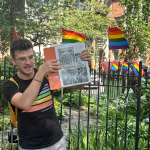Today, we recognize October as LGBTQ+ History Month – a time to honor the legacy, resilience, and contributions of the LGBTQ+ community. But what we don’t always pause to consider is how this month began, or the person whose vision sparked what has now become a global observance.
The origins of LGBTQ+ History Month echo a theme we often share on our tours: history is shaped by individuals and small collectives who dared to create positive social change. This month is no exception. What began as the dream of one teacher grew into an inspired vision that spread across the country and, eventually, around the world.
In 1994, Rodney Wilson was a high school history teacher in Missouri. As he looked through his school’s curriculum, he noticed something interesting: classrooms recognized Black History Month in February and Women’s History Month in March, but there was no time dedicated to LGBTQ+ history. In fact, there wasn’t any LGBTQ+ history in the textbooks at all.
Rodney was a gay man himself. He was out to his family and friends, but not at school, because at that time, he could lose his job for being an openly gay teacher. Imagine standing in front of a classroom every day, passionate about history, but knowing that the history of your own community wasn’t allowed to be told. One day, during a lesson on the Holocaust, Wilson pointed to the pink triangle symbol once used to mark queer prisoners and bravely told his students that this symbol could have been used for people like him. For the time, it was a radical act of visibility and representation, both for himself and within history.

That moment sparked a larger idea: what if there were a month dedicated to recognizing LGBTQ+ history? What if there was space to ensure that the contributions of LGBTQ+ people were not erased, but honored and remembered? Soon after, Rodney wrote to the National Gay and Lesbian Task Force with his proposal. His goal was for a recognized month where schools could teach LGBTQ+ history in an intentional and meaningful way.
The Task Force fully embraced the idea, and that very October – October 1994 – the first LGBTQ+ History Month was born. Rodney chose October for a reason: it included National Coming Out Day on October 11, and it fell during the school year, giving teachers an opportunity to bring LGBTQ+ history into the classroom.
Rodney’s story is a reminder that change doesn’t always begin with a formal organization or an activist movement. It can start with a single person. He noticed a need, took a courageous step, and opened a door into something larger than himself. What began in one classroom now resonates across the country every October, both in and out of schools.
On our tours, we share similar stories again and again – moments when individuals or small collectives saw a need for change and acted on it. These stories remind us that history is made by real people, just like us, who envisioned a more inclusive world.
Rodney Wilson showed us that sometimes, all it takes is one person. If you believe a story deserves to be told, you can begin telling it. And sometimes, your small act can ripple outward into something far larger than you ever imagined.




